实验五
Posted yyt20011109
tags:
篇首语:本文由小常识网(cha138.com)小编为大家整理,主要介绍了实验五相关的知识,希望对你有一定的参考价值。
// 这个程序用于观察数组中的一组数据元素在内存中是否是连续存放的 // 以及数组元素的直接访问与间接访问 #include <stdio.h> #include <stdlib.h> const int N=3; int main() { int a[N] = {1, 2, 3}; // 定义一维数组a,包含3个整型数据,并对其初始化,3个元素初始值分别是1,2,3 int i; // 以"地址:值"的形式打印数组a中每一个数据元素的地址,和数据元素值 printf("通过数组名及下标直接访问数组元素: "); for(i=0; i<N; i++) printf("%d: %d ", &a[i], a[i]); // 以"地址:值"的形式打印数组a中每一个数据元素的地址,和数据元素值 printf("通过地址间接访问数组元素: "); for(i=0; i<N; i++) printf("%d: %d ", a+i, *(a+i)); system("pause"); return 0; }
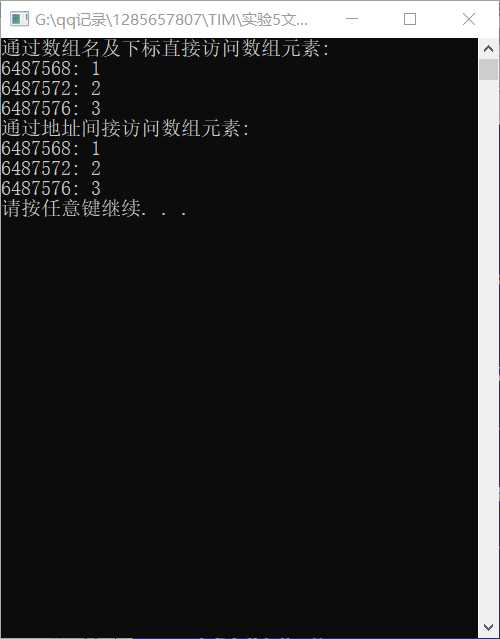
// 这个程序用于观察二维数组在内存中的存放 // 以及二维数组中的地址:元素的地址、行地址 #include <stdio.h> #include <stdlib.h> const int LINE=2; const int COL=3; int main() { int a[LINE][COL] = {1,2,3,4,5,6}; int i,j; // 以"地址:值"的形式打印数组a中每一个数据元素的地址,和数据元素值 printf("通过数组名及下标直接访问数组元素: "); for(i=0; i<LINE; i++) for(j=0; j<COL; j++) printf("%d: %d ", &a[i][j], a[i][j]); // 以"地址:值"的形式打印数组a中每一个数据元素的地址,和数据元素值 printf("通过地址间接访问数组元素: "); for(i=0; i<LINE; i++) for(j=0; j<COL; j++) printf("%d: %d ", a[i]+j, *(a[i]+j)); // 观察二维数组中a+i的值,思考其表示的地址 printf("二维地址中a+i表示的地址: "); for(i=0; i<LINE; i++) printf("%d ", a+i); system("pause"); return 0; }

// 使用指针变量间接访问一维数组 #include <stdio.h> #include <stdlib.h> const int N=3; int main() { int a[N]; int *p,i; // 通过指针变量p,完成数组元素输入 for(p=a; p<a+N; p++) scanf("%d", p); // 过指针变量p,完成数组元素输出 for(p=a; p<a+N; p++) printf("%d ", *p); printf(" "); p = a; //通过指针变量p,完成数组元素输入 for(i=0; i<N; i++) scanf("%d", p+i); // 通过指针变量p,完成数组元素输出 for(i=0; i<N; i++) printf("%d ", *(p+i)); printf(" "); system("pause"); return 0; }

// 使用指针变量间接访问二维数组 #include <stdio.h> #include <stdlib.h> int main() { int a[2][3] = {1,2,3,4,5,6}; int i,j; int *p; // p是指针变量,存放int型数据的地址 int (*q)[3]; // q是指针变量,存放包含有 3个元素的一维数组的地址 // 通过指针变量p间接访问,输出二维数组a的元素值 for(p=a[0]; p<a[0]+6; p++) printf("%d ", *p); printf(" "); // 通过行指针变量q间接访问,输出二维数组a的元素值 for(q=a; q<a+2; q++) for(j=0; j<3; j++) printf("%d ", *(*q+j)); printf(" "); system("pause"); return 0; }
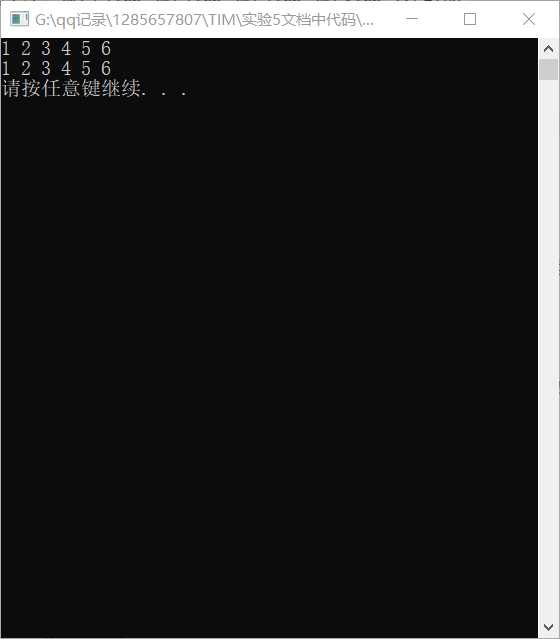
2.1
// 练习:使用二分查找,在一组有序元素中查找数据项 // 形参是数组,实参是数组名 #include <stdio.h> #include <stdlib.h> const int N=5; int binarySearch(int x[], int n, int item); // 函数声明 int main() { int a[N]={2,7,19,45,66}; int i,index, key; printf("数组a中的数据: "); for(i=0;i<N;i++) printf("%d ",a[i]); printf(" "); printf("输入待查找的数据项: "); scanf("%d", &key); // 调用函数binarySearch()在数组a中查找指定数据项item,并返回查找结果给index // 补足代码① // ××× index=binarySearch(a,5,key); if(index>=0) printf("%d在数组中,下标为%d ", key, index); else printf("%d不在数组中 ", key); system("pause"); return 0; } //函数功能描述: //使用二分查找算法在数组x中查找特定值item,数组x大小为n // 如果找到,返回其下标 // 如果没找到,返回-1 int binarySearch(int x[], int n, int item) { int low, high, mid; low = 0; high = n-1; while(low <= high) { mid = (low+high)/2; if (item == x[mid]) return mid; else if(item < x[mid]) high = mid - 1; else low = mid + 1; } return -1; }

/* N个字典序的整数已放在一维数组中,给定下列程序中,函数fun的功能是: 利用折半查找算法查找整数m在数组中的位置。 若找到,则返回其下标值;反之,则返回-1 */ #include <stdio.h> #include <stdlib.h> #define N 10 int fun(int *a,int m) { int low = 0, high = N-1, mid; /*************ERROR**************/ while(low <= high) { mid = (low+high)/2; /*************ERROR**************/ if(m < *(a+mid)) high = mid-1; /*************ERROR**************/ else if(m > *(a+mid)) low = mid+1; else return(mid); } return(-1); } int main() { int i,a[N]={-3,4,7,9,13,24,67,89,100,180},k,m; printf("a数组中的数据如下: "); for(i=0;i<N;i++) printf("%d ",a[i]); printf(" Enter m: "); scanf("%d",&m); /*************ERROR**************/ k = fun(a,m); if (k>=0) printf("m=%d,index=%d ",m,k); else printf("Not be found! "); system("pause"); return 0; }
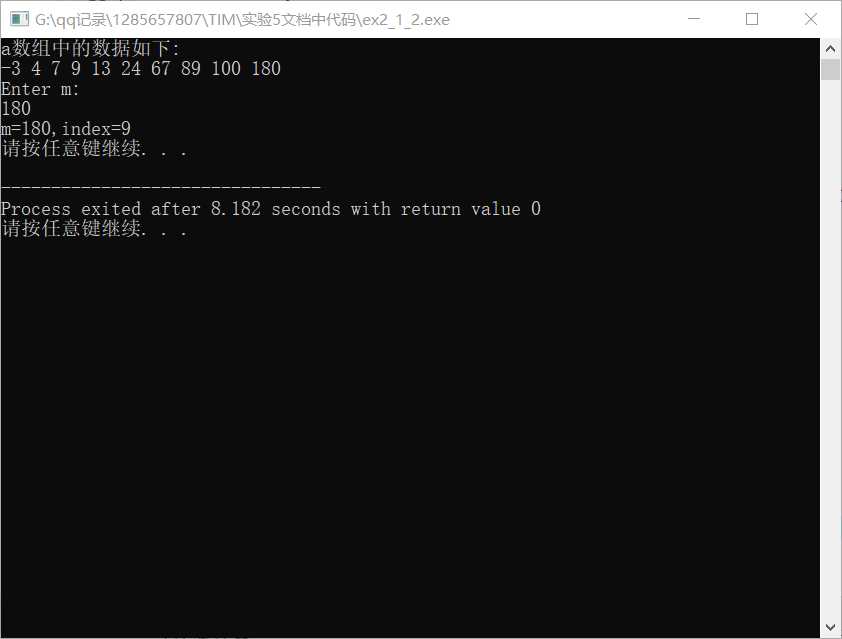
// 练习:使用选择法对字符串按字典序排序 #include <stdio.h> #include <string.h> #include <stdlib.h> void selectSort(char str[][20], int n ); // 函数声明,形参str是二维数组名 int main() { char name[][20] = {"John", "Alex", "Joseph", "Taylor", "George"}; int i; printf("输出初始名单: "); for(i=0; i<5; i++) printf("%s ", name[i]); selectSort(name, 5); // 调用选择法对name数组中的字符串排序 printf("按字典序输出名单: "); for(i=0; i<5; i++) printf("%s ", name[i]); system("pause"); return 0; } // 函数定义 // 函数功能描述:使用选择法对二维数组str中的n个字符串按字典序排序 void selectSort(char str[][20], int n) { // 补足代码 // ××× int i,j,k; char m[20]; for(i=0;i<n-1;i++){ k=i; for(j=i+1;j<n;j++) if(strcmp(str[j],str[k])<0) k=j; if(k!=i){ strcpy(m,str[i]); strcpy(str[i],str[k]); strcpy(str[k],m); } } }
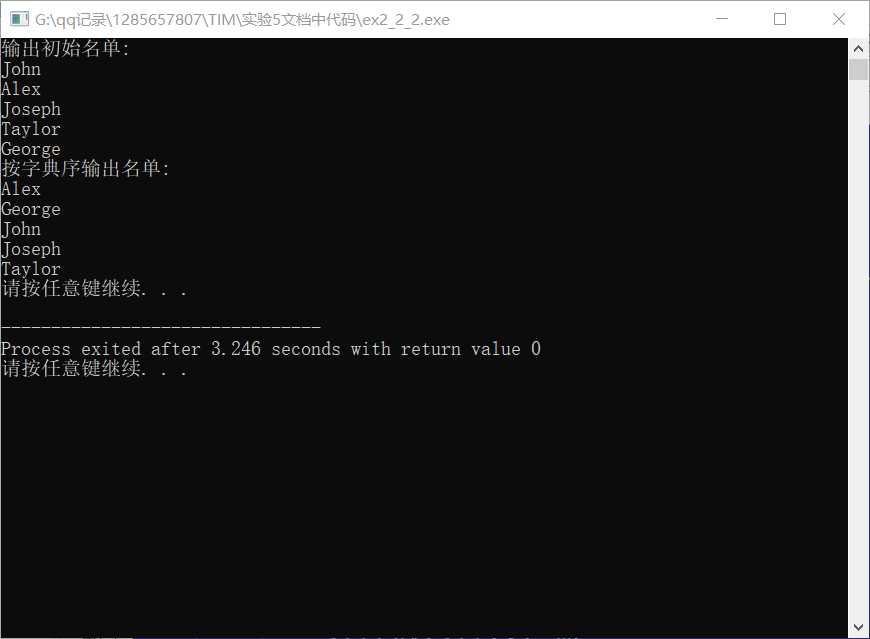
/* 假定输入的字符串中只包含字母和*号。 编写函数,实现: 除了字符串前导的*号之外,将串中其他*号全部删除。 在编写函数时,不得使用C语言提供的字符串函数。 例如,若字符串中的内容为****A*BC*DEF*G******* 删除后,字符串中的内容则应当是****ABCDEFG */ #include <string.h> #include <stdio.h> #include <stdlib.h> void fun(char *a) { /*****ERROR********/ int i=0; char *p = a; /****ERROR***/ while( *p == ‘*‘&& *p!=0) { a[i] = *p; i++; p++; } while(*p) { /******ERROR*******/ if(*p != ‘*‘) { a[i] = *p; i++; } p++; } /******ERROR*******/ a[i] = 0; } int main() { char s[81]; printf("Enter a string : "); gets(s); /***ERROR******/ fun(s); printf("The string after deleted: "); puts(s); system("pause"); return 0; }
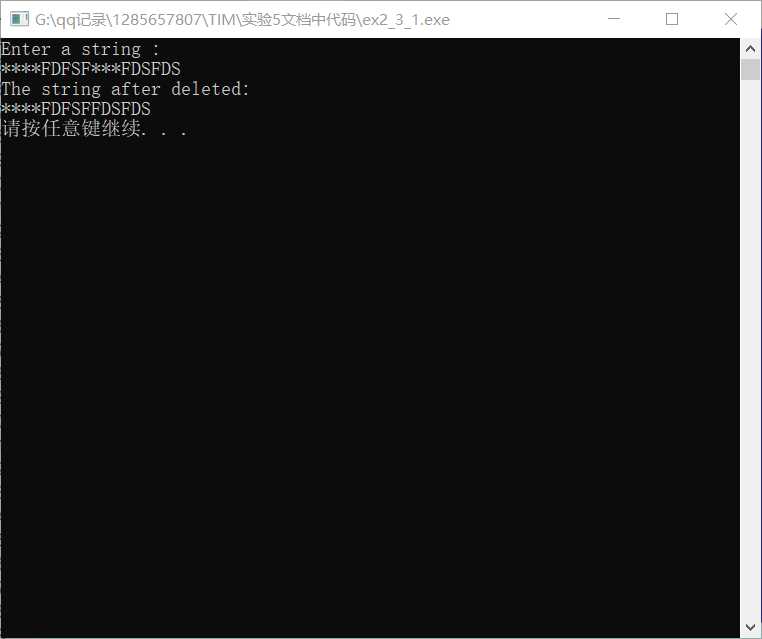
/* 假定输入的字符串中只包含字母和*号。 编写函数,实现: 除了字符串前导和尾部的*号之外,将串中其他*号全部删除。 在编写函数时,不得使用C语言提供的字符串函数。 例如,若字符串中的内容为****A*BC*DEF*G******* 删除后,字符串中的内容则应当是****ABCDEFG****** */ #include <stdio.h> #include <stdlib.h> #include <string.h> void fun(char *a) { /**ERROR******/ int i=0; char *t = a, *f = a; char *q = a; while(*t) t++; t--; while(*t == ‘*‘) t--; while(*f == ‘*‘) f++; /***ERROR***/ while (q<f) { a[i] = *q; q++; i++; } while (q<t) { /***ERROR**/ if(*q != ‘*‘) { a[i] = *q; i++; } q++; } while (*q) { a[i] = *q; i++; q++; } /**ERROR**/ a[i]=0; } int main () { char s[81]; printf("Entre a string: "); gets(s); /**ERROR**/ fun(s); printf("The sting after deleted: "); puts(s); system("pause"); return 0; }
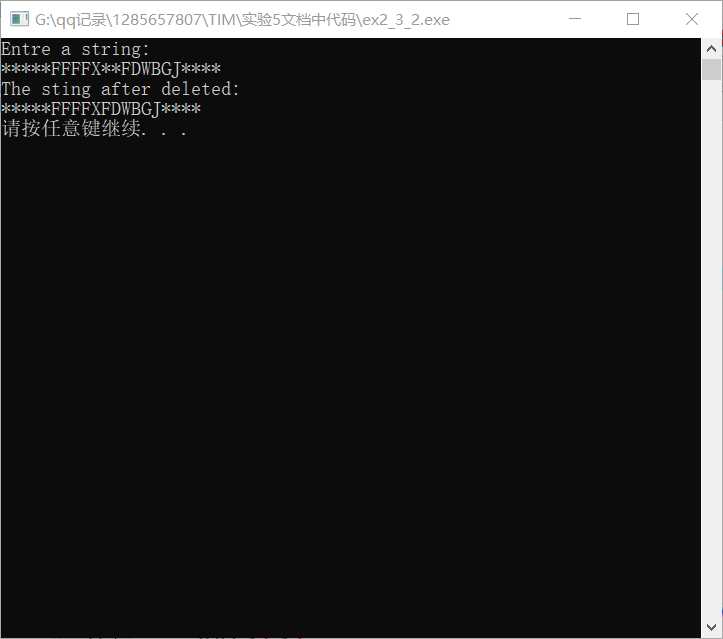
以上是关于实验五的主要内容,如果未能解决你的问题,请参考以下文章